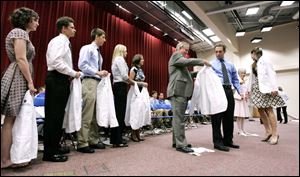
University of Toledo gets $1.13M NASA grant for solar-panel testing center
8/23/2008
Dr. Ronald McGinnis, center, an associate dean at the University of Toledo college of medicine, formerly the Medical College of Ohio, helps one of 176 new medical students into his doctor s white coat yesterday at the White Coat Ceremony on the UT campus.
The University of Toledo has received $1.13 million from NASA to fund a solar-panel testing center, a grant which university officials said will help the region cement itself as the alternative-energy capital of the Midwest.
"This will make our future a lot brighter in a lot of ways," U.S. Rep. Marcy Kaptur, (D., Toledo) said yesterday during a news conference at the university with the school's president, Dr. Lloyd Jacobs.
The Lucas County commissioners have pledged to contribute $100,000 to the project for a local match. The money will come from the county's economic development fund, which has about $200,000 from the sale of land last year.
Although the grant is more than a million dollars, ultimately UT will see about $750,000 after paying NASA a leasing fee of $478,000, according to Frank Calzonetti, vice president of research development for the university.
Mr. Calzonetti said the testing center could be a boon to Toledo's economy by attracting alternative-energy companies.
"The real benefit will be in the fact that it will attract activity into Toledo," Mr. Calzonetti said. "It will make Toledo a very important place to be - if one's in the solar-panel business."
Officials said the center will be one of the few places in the country to test solar-energy producers - technically called photovoltaic technology.
Once it is up and running in the university's Clean Alternative Energy Incubator, the center will test hundreds of panels sent in from companies throughout the Midwest.
Currently, most of those companies have to ship their products to Colorado to be tested.
Today the building is a vacant warehouse - but according to Michael Heben, a professor hired by the university to research alternative energy, within a year it will be filled with "solar simulators" to test and calibrate solar panels.
According to Miss Kaptur's office, the center eventually will become a "certification center" to give solar panels official certification for use, saving Xunlight Corp. and First Solar Inc. shipping costs.
The commissioners will vote on the $100,000 appropriation at their meeting on Tuesday. All three commissioners have said they'll support the funding. Tina Skeldon Wozniak, the president of the commissioners, said Toledo will become famous as a producer of solar-powered technology.
"We are going to be world-recognized," she said. "•'Solar' is going to become a household word here in Toledo, as it should."
UT's ties to the solar-panel business go back nearly two decades. Many point to the late Harold McMaster, the Toledo inventor who helped start First Solar's forerunner, Solar Cells, and who is seen as a pioneer in the field of alternative energy. He donated millions to the university. Last May, the family donated $2 million to establish the Harold and Helen McMaster chair in photovoltaics. The physics and astronomy building is called McMaster Hall.
"I knew I met the 20th-century version of Thomas Alva Edison," said Miss Kaptur, speaking with emotion as she recalled Mr. McMaster's dream of a gigantic solar array, supplying all of Earth's energy.
Today the university houses the Wright Center for Photovoltaics Innovation and the University Clean Energy Alliance of Ohio.
Contact Alex M. Parker at:
aparker@theblade.com
or 419-724-6107.